A Petunia homeodomain-leucine zipper protein, PhHD-Zip, plays an important role in flower senescence
- PMID: 24551088
- PMCID: PMC3925126
- DOI: 10.1371/journal.pone.0088320
A Petunia homeodomain-leucine zipper protein, PhHD-Zip, plays an important role in flower senescence
Abstract
Flower senescence is initiated by developmental and environmental signals, and regulated by gene transcription. A homeodomain-leucine zipper transcription factor, PhHD-Zip, is up-regulated during petunia flower senescence. Virus-induced gene silencing of PhHD-Zip extended flower life by 20% both in unpollinated and pollinated flowers. Silencing PhHD-Zip also dramatically reduced ethylene production and the abundance of transcripts of genes involved in ethylene (ACS, ACO), and ABA (NCED) biosynthesis. Abundance of transcripts of senescence-related genes (SAG12, SAG29) was also dramatically reduced in the silenced flowers. Over-expression of PhHD-Zip accelerated petunia flower senescence. Furthermore, PhHD-Zip transcript abundance in petunia flowers was increased by application of hormones (ethylene, ABA) and abiotic stresses (dehydration, NaCl and cold). Our results suggest that PhHD-Zip plays an important role in regulating petunia flower senescence.
Conflict of interest statement
Figures
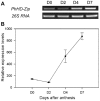

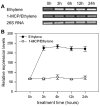
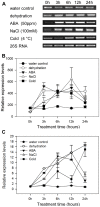


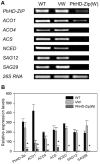
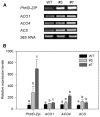

Similar articles
-
Functional characterization of PhGR and PhGRL1 during flower senescence in the petunia.Plant Cell Rep. 2015 Sep;34(9):1561-8. doi: 10.1007/s00299-015-1808-7. Epub 2015 May 19. Plant Cell Rep. 2015. PMID: 25987314
-
Identification and expression analysis of ERF transcription factor genes in petunia during flower senescence and in response to hormone treatments.J Exp Bot. 2011 Jan;62(2):825-40. doi: 10.1093/jxb/erq324. Epub 2010 Oct 25. J Exp Bot. 2011. PMID: 20974735 Free PMC article.
-
Overproduction of cytokinins in petunia flowers transformed with P(SAG12)-IPT delays corolla senescence and decreases sensitivity to ethylene.Plant Physiol. 2003 Aug;132(4):2174-83. doi: 10.1104/pp.103.023945. Plant Physiol. 2003. PMID: 12913172 Free PMC article.
-
Role of Homeodomain leucine zipper (HD-Zip) IV transcription factors in plant development and plant protection from deleterious environmental factors.Int J Mol Sci. 2013 Apr 12;14(4):8122-47. doi: 10.3390/ijms14048122. Int J Mol Sci. 2013. PMID: 23584027 Free PMC article. Review.
-
HD-ZIP Gene Family: Potential Roles in Improving Plant Growth and Regulating Stress-Responsive Mechanisms in Plants.Genes (Basel). 2021 Aug 17;12(8):1256. doi: 10.3390/genes12081256. Genes (Basel). 2021. PMID: 34440430 Free PMC article. Review.
Cited by
-
Transcriptomic analysis reveals numerous diverse protein kinases and transcription factors involved in desiccation tolerance in the resurrection plant Myrothamnus flabellifolia.Hortic Res. 2015 Jul 22;2:15034. doi: 10.1038/hortres.2015.34. eCollection 2015. Hortic Res. 2015. PMID: 26504577 Free PMC article.
-
"Pathomorphogenic" Changes Caused by Citrus Bark Cracking Viroid and Transcription Factor TFIIIA-7ZF Variants Support Viroid Propagation in Tobacco.Int J Mol Sci. 2023 Apr 24;24(9):7790. doi: 10.3390/ijms24097790. Int J Mol Sci. 2023. PMID: 37175498 Free PMC article.
-
A basic helix-loop-helix transcription factor, PhFBH4, regulates flower senescence by modulating ethylene biosynthesis pathway in petunia.Hortic Res. 2015 Dec 16;2:15059. doi: 10.1038/hortres.2015.59. eCollection 2015. Hortic Res. 2015. PMID: 26715989 Free PMC article.
-
How far can omics go in unveiling the mechanisms of floral senescence?Biochem Soc Trans. 2023 Aug 31;51(4):1485-1493. doi: 10.1042/BST20221097. Biochem Soc Trans. 2023. PMID: 37387359 Free PMC article.
-
Molecular interactions of the γ-clade homeodomain-leucine zipper class I transcription factors during the wheat response to water deficit.Plant Mol Biol. 2016 Mar;90(4-5):435-52. doi: 10.1007/s11103-015-0427-6. Epub 2016 Jan 23. Plant Mol Biol. 2016. PMID: 26803501
References
-
- van Doorn WG (2001) Categories of petal senescence and abscission: A re-evaluation. Annals of Botany 87: 447–456.
-
- Thomas H, Ougham HJ, Wagstaff C, Stead AD (2003) Defining senescence and death. Journal of Experimental Botany 54: 1127–1132. - PubMed
-
- Porat R, Reuveny Y, Borochov A, Halevy AH (1993) Petunia flower longevity - the role of sensitivity to ethylene. Physiologia Plantarum 89: 291–294.
Publication types
MeSH terms
Substances
Associated data
- Actions
- Actions
- Actions
- Actions
- Actions
- Actions
- Actions
- Actions
- Actions
- Actions
- Actions
- Actions
- Actions
- Actions
- Actions
- Actions
- Actions
Grants and funding
LinkOut - more resources
Full Text Sources
Other Literature Sources

